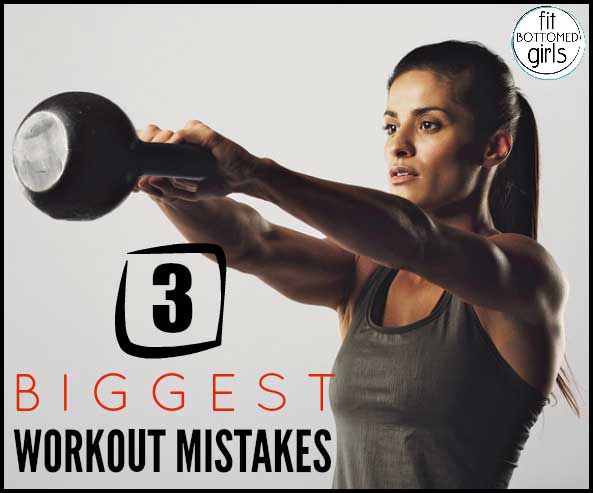3 Biggest Workout Mistakes and How to Fix Them
 I may be slightly biased because I do these kinds of workouts regularly, but over the last year or so, it seems that the new workout trend is to go hard. Whether it’s plyometrics, kettlebell training or high-intensity interval training, the point is to take your fitness to another level by pushing your body perhaps further than you knew it could go. Which is awesome. I’m a huge fan of pushing yourself and seeing exactly what you can do when you put your mind to it. HOWEVER, super-intense workouts are no joke, and a workout mistake here or there like bad form or going too hard too fast can led to injury, pain and burnout. Which is why we wanted to share these three fixes for most common workout mistakes from the American Council on Exercise’s Exercise Physiologist Jessica Matthews provides. Here’s to an effective—and safe—workout!
I may be slightly biased because I do these kinds of workouts regularly, but over the last year or so, it seems that the new workout trend is to go hard. Whether it’s plyometrics, kettlebell training or high-intensity interval training, the point is to take your fitness to another level by pushing your body perhaps further than you knew it could go. Which is awesome. I’m a huge fan of pushing yourself and seeing exactly what you can do when you put your mind to it. HOWEVER, super-intense workouts are no joke, and a workout mistake here or there like bad form or going too hard too fast can led to injury, pain and burnout. Which is why we wanted to share these three fixes for most common workout mistakes from the American Council on Exercise’s Exercise Physiologist Jessica Matthews provides. Here’s to an effective—and safe—workout!
3 Workout Mistakes to Avoid
1. Kettlebells. Research confirms that kettlebell workouts are an extremely effective form of training that can be performed in a relatively short period of time. The problem lies in that many people who do them don’t understand the proper mechanics for the exercises. For example, many incorrectly perceive the kettlebell single arm swing as a shoulder exercise, when it should be working the core.
The Fix: When performing the kettlebell single arm swing, avoid lifting with your back or your shoulders. Like in many kettlebell exercises, the hips should always drive the movement. To execute this movement correctly, brace your core (contracting your abdominal muscles) and hinge at your hips. As you exhale, initiate an explosive upward movement to swing the kettlebell upward coming to a standing position. The momentum generated through the lower body should allow the arm to become parallel with the floor with neutral alignment maintained through the wrists. Having trouble? If you find you are unable to achieve the desired arm position, attempt to generate more power from the lower body by thrusting harder with your gluteal (butt) muscles from the lowered position.

Comments
I can definitely vouch for the kettlebell advice! I do CrossFit, and hated any workout involving KBs because I found the movement to be impossible. Turns out, when you let your hips do the work and hinge rather than swing, you feel SO much more powerful [maybe they should stop calling them KB “swings” – it’s quite misleading!]. I was lucky to get the movement down before suffering a back injury, and was INSTANTLY able to grab a KB ten pounds heavier. My tip is: you know you’re doing it right if your glutes BURN after the workout!
You’ve hit on some of the biggest dangers lurking for people new to exercise! Regarding plyometrics, landing is a critical skill that is not taught. This leads to injuries for girls who end up playing things like soccer. We like to have people START from a good landing position and drive into “triple extension” – finishing with their arms in the air. Kind of jumping in reverse.
Great Post….The KettleBell might be the single greatest piece of workout equipment ever made!! If you are just getting started with the bell or not sure what weight to get, you may want to make a T-Handle….perfect for 1 or 2 hand swings, and to figure out what weight you should be using.
RKC delivered to your door get wicked expensive. I put up a how to video if you are not familiar with the T-Handle or Hungarian Core Blaster as it’s also called
http://xtremestack.com/kettlebells-are-expensive-make-one-at-home-its-easy/
Hope this helps save you some dough, Great post
Great insights in all three areas. Form, posture and body mechanics are hugely important factors that dictate the overall effectiveness of a workout.
This advice about landing doesn’t make sense. When you land from a jump, just as you would when you step down a stair, you land on the ball of your foot, not mid foot. The true reverse of the jump is to use the ball of the foot as the initial landing point, to use the calf muscles before the force transfers to the knee. You wouldn’t go from mid foot TO the ball. You’ll always land on the ball of the foot first.
But yes, land softly. Like a ninja.
Good article, there were a few new to me ideas.
Comments are closed.